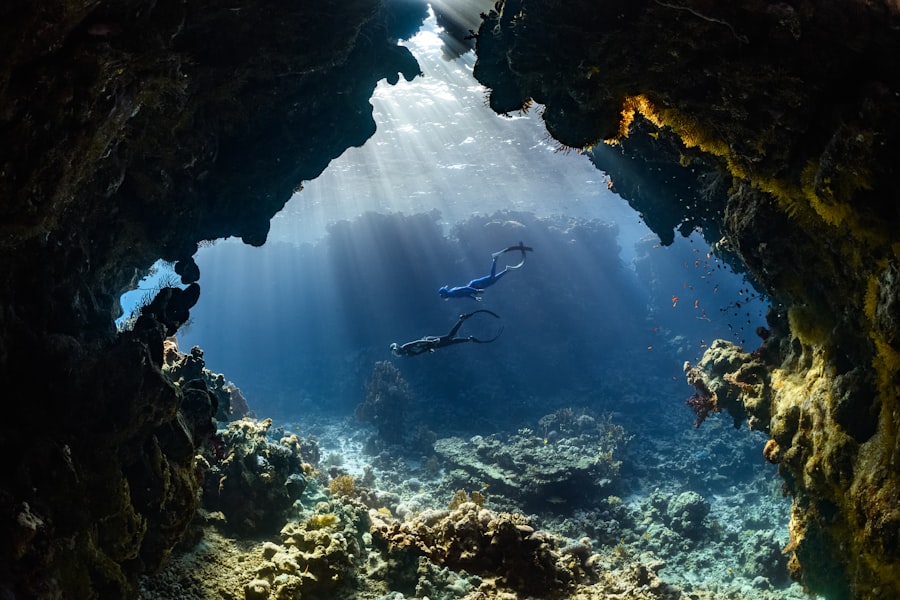Download links
How to install Exploring the Shallow Sea: A Diver's Adventure APK?
1. Tap the downloaded Exploring the Shallow Sea: A Diver's Adventure APK file.
2. Touch install.
3. Follow the steps on the screen.
Description
Shallow sea diving offers a unique and enchanting experience that captivates both novice and seasoned divers alike.
Unlike deeper dives, where light diminishes and visibility can be compromised, shallow waters often boast crystal-clear conditions, allowing divers to fully appreciate the intricate details of marine life.
The interplay of sunlight filtering through the water creates a mesmerizing spectacle, illuminating coral reefs and underwater landscapes in a kaleidoscope of colors. Moreover, shallow sea diving provides an intimate connection with the underwater world. Divers can glide effortlessly over coral gardens, observing the delicate balance of life that exists in these ecosystems.
The proximity to the surface allows for a more relaxed diving experience, where one can take the time to explore and appreciate the myriad of species that inhabit these waters. Whether it’s the graceful movements of a sea turtle or the vibrant hues of a clownfish darting among anemones, shallow sea diving offers a front-row seat to nature’s wonders, making it an unforgettable adventure.
Key Takeaways
- Shallow sea diving offers a unique opportunity to explore vibrant marine life and stunning underwater landscapes.
- Diving techniques for shallow waters focus on buoyancy control and gentle movements to avoid disturbing delicate ecosystems.
- Marine life encounters in shallow seas can include colorful coral reefs, tropical fish, sea turtles, and other fascinating creatures.
- Environmental conservation is crucial for preserving shallow sea ecosystems, and divers can contribute by following responsible diving practices and supporting conservation efforts.
- Safety precautions for shallow sea diving include proper equipment maintenance, thorough dive planning, and staying within safe depth limits.
- Best shallow sea diving locations around the world include the Great Barrier Reef in Australia, the Red Sea in Egypt, and the Maldives for their diverse marine life and clear waters.
Diving Techniques for Shallow Waters
Buoyancy Control: The Key to Stability
One fundamental technique is buoyancy control, which is crucial for maintaining stability while exploring the underwater environment. Divers should practice using their BCD (buoyancy control device) effectively to achieve neutral buoyancy. This allows them to hover effortlessly above the seabed without disturbing delicate marine habitats. Mastering this skill not only enhances the diving experience but also minimizes the risk of damaging fragile coral formations.
Proper Finning Techniques
Another important technique is proper finning. In shallow waters, divers often encounter varying depths and terrain, which can require different finning styles. A gentle flutter kick is often more effective than a strong kick, as it allows for better control and reduces the likelihood of stirring up sediment that can cloud visibility.
Maintaining a Streamlined Posture
Additionally, divers should be mindful of their body position; keeping a streamlined posture helps conserve energy and maintain balance while navigating through underwater currents or around obstacles like rocks and coral.
Marine Life Encounters in Shallow Seas

The shallow seas are teeming with diverse marine life, making them a prime location for encounters with fascinating species. Coral reefs, often found in these areas, serve as bustling hubs of biodiversity. Divers may find themselves surrounded by schools of colorful fish, such as parrotfish and damselfish, which dart in and out of coral formations.
The presence of larger species, like rays and juvenile sharks, adds an element of excitement to shallow dives, as these creatures often venture into shallower waters to hunt or seek refuge. In addition to fish, shallow sea environments are home to a variety of invertebrates that contribute to the richness of marine life. Sea stars, sea urchins, and anemones can be spotted clinging to rocks or nestled within coral crevices.
The opportunity to observe these creatures up close allows divers to appreciate their unique adaptations and behaviors. For instance, watching a sea cucumber slowly move across the ocean floor or witnessing a hermit crab switch shells can provide insights into the intricate relationships that exist within these ecosystems.
Environmental Conservation and Shallow Sea Diving
| Metrics | Data |
|---|---|
| Number of Marine Protected Areas | 5000 |
| Percentage of Coral Reefs Threatened | 30% |
| Number of Endangered Species in Shallow Seas | 1000 |
| Amount of Plastic Waste in Oceans | 8 million tons |
As the popularity of shallow sea diving continues to grow, so does the importance of environmental conservation efforts in these fragile ecosystems. Divers play a crucial role in promoting awareness about marine conservation issues, such as coral bleaching and overfishing. By participating in organized clean-up dives or citizen science projects, divers can contribute directly to the health of marine environments.
These initiatives not only help remove debris from the ocean but also foster a sense of responsibility among divers to protect the underwater world they cherish. Furthermore, many dive operators are now adopting sustainable practices to minimize their impact on marine ecosystems. This includes implementing guidelines for responsible diving behavior, such as avoiding contact with coral and refraining from feeding fish.
Educating divers about the significance of marine protected areas (MPAs) is also essential; these designated zones help safeguard critical habitats from destructive activities. By supporting dive operators that prioritize conservation, divers can ensure that future generations will have the opportunity to experience the beauty of shallow sea diving.
Safety Precautions for Shallow Sea Diving
While shallow sea diving is generally considered safer than deeper dives, it is essential for divers to adhere to specific safety precautions to ensure a secure experience. One fundamental aspect is proper training and certification. Divers should complete a recognized diving course that covers essential skills and safety protocols before venturing into any underwater environment.
This training equips divers with knowledge about equipment use, emergency procedures, and how to recognize potential hazards. Another critical safety measure is maintaining situational awareness while diving. Divers should always be mindful of their surroundings, including currents, weather conditions, and other divers in the area.
It is advisable to dive with a buddy system; having a partner not only enhances safety but also enriches the experience through shared exploration. Additionally, divers should establish clear communication signals before entering the water to ensure they can effectively convey any concerns or needs during the dive.
Best Shallow Sea Diving Locations around the World

Renowned Dive Sites
One such destination is the Great Barrier Reef in Australia, renowned for its stunning coral formations and diverse marine life. With numerous dive sites accessible from the shore or via boat, divers can explore vibrant reefs teeming with fish while enjoying excellent visibility. The shallow waters around Heron Island are particularly popular for their rich biodiversity and opportunities for encounters with turtles and rays.
Crystal-Clear Waters
Another remarkable location is Cozumel in Mexico, where crystal-clear waters provide an ideal setting for shallow diving adventures. The Palancar Reef offers breathtaking coral structures and an abundance of marine species, making it a favorite among divers seeking vibrant underwater scenery. The warm waters and gentle currents create an inviting environment for both beginners and experienced divers alike.
Global Dive Destinations
In Southeast Asia, Thailand’s Koh Tao stands out as a premier destination for shallow sea diving. Known for its stunning beaches and vibrant nightlife, Koh Tao also boasts some of the best dive sites in the region. Aow Leuk Bay is particularly famous for its calm waters and rich marine life, including colorful reef fish and occasional sightings of larger species like whale sharks. The Caribbean also offers numerous shallow diving spots worth exploring. Bonaire is often hailed as one of the best diving destinations globally due to its commitment to marine conservation and accessible dive sites right off the shore.
FAQs
What is shallow sea diving?
Shallow sea diving refers to the activity of diving in relatively shallow waters, typically up to 40 feet deep. It is popular among beginner and intermediate divers due to the shallower depths and generally calmer conditions.
What are the benefits of shallow sea diving?
Shallow sea diving allows divers to explore vibrant marine life, colorful coral reefs, and underwater landscapes without the need for advanced diving certifications or specialized equipment. It also provides an opportunity for divers to improve their skills and build confidence in a controlled environment.
What are some popular shallow sea diving destinations?
Popular shallow sea diving destinations include the Caribbean, the Red Sea, the Great Barrier Reef in Australia, and various coastal areas around the world. These locations offer diverse marine ecosystems and clear, warm waters ideal for shallow sea diving.
What equipment is needed for shallow sea diving?
Basic scuba diving equipment such as a mask, snorkel, fins, wetsuit, buoyancy control device (BCD), regulator, and dive computer are essential for shallow sea diving. Additionally, a weight belt, dive light, and underwater camera may be used depending on the specific dive site and personal preferences.
What safety precautions should be taken for shallow sea diving?
Before engaging in shallow sea diving, it is important to undergo proper training and certification from a recognized diving organization. Divers should always dive with a buddy, adhere to safe diving practices, and be aware of potential hazards such as marine life encounters, currents, and changes in water conditions. Regular equipment maintenance and dive site research are also crucial for a safe diving experience.





